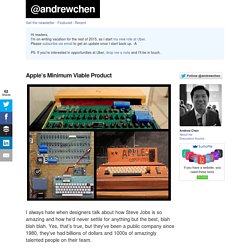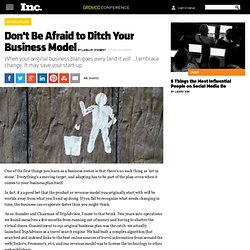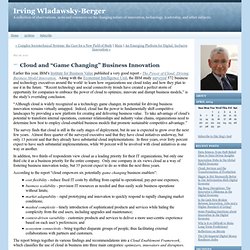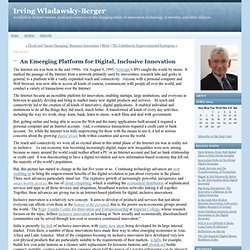

Make Agility Part of Your Process - Walter Popper, Brad Power, and Steve Stanton. By Walter Popper, Brad Power, and Steve Stanton | 10:00 AM January 17, 2013 Rational managers for the past thirty years have tightly focused on efficiency, cost cutting, and day-to-day execution — perhaps to a fault.

With increasing industry disruption, efficiency is fast becoming of secondary importance to innovation and agility. Many large organizations have too little capacity for external sensing, strategic reflection, and business transformation. As a recent WalMart staff proposal stated “We have cut costs too far, stores are understaffed, and associates cannot provide customers with the service that Sam Walton built the company on, and that we are proud to provide…” In stark contrast, at a disruptive organization like Google, innovation is built into jobs through “20% time” projects — engineers are expected to spend 20% of their time on projects that are creating and testing new ideas. 1.
The Messy Business of Management. Accelerating Innovation In The New Corporate Garage: Innosight. Think Like A Lean Startup For BPM Success. Marc Andreessen: Not every startup should be a Lean Startup or embrace the pivot. The Lean Startup philosophy and Marc Andreessen are themselves two institutions in Silicon Valley, so when one weighs in on the other, it’s good to take note.

The famed investor spoke Monday about his three pet peeves in investor pitches, most of which are related to entrepreneurs misappropriating or misusing the Lean Startup approach, an approach that encourages quick scaling to achieve success. “I feel like we’ve discovered the theory of relativity,” Andreessen joked on the Lean Startup approach, noting seriously that he admires Eric Ries’ now-ubiquitous approach to building startups.
Ries’ model, which encourages quick iteration and inexpensive prototyping before investing big money, has become somewhat of a guiding principle for many companies in Silicon Valley. But Andreessen, speaking with Ries Monday at the Lean Startup conference in San Francisco, noted that there are three ways entrepreneurs can run astray: Not all startups can be Lean Startups Don’t develop a “fetish for failure” Seeing with a Wide Lens. The Top 20 Most Influential Agile People. Apple’s Minimum Viable Product. I always hate when designers talk about how Steve Jobs is so amazing and how he’d never settle for anything but the best, blah blah blah.

When "Creative Destruction" Destroys More than It Creates - Chris Zook. When changes in the natural environment accelerate, so do the extinction rates of the Earth’s creatures.

It happened to the dinosaurs and again to many species during the Ice Age. Many scientists believe we may be entering another such period . Lean Manufacturing, Toyota Production System, Historical Timeline Lean. Don't Be Afraid to Ditch Your Business Model. One of the first things you learn as a business owner is that there's no such thing as "set in stone.

" Everything's a moving target, and adapting has to be part of the plan-even when it comes to your business plan itself. In fact, it's a good bet that the product or revenue model you originally start with will be worlds away from what you'll end up doing. If you fail to recognize what needs changing in time, the business can evaporate faster than you might think. As co-founder and Chairman of TripAdvisor, I came to that brink. Home [Lean Agile Wiki]
The Lean Stack – Part 1. Cloud and “Game Changing” Business Innovation. Earlier this year, IBM’s Institute for Business Value published a very good report - The Power of Cloud: Driving Business Model Innovation.

Along with the Economist Intelligence Unit, the IBM study surveyed 572 business and technology executives around the world to learn how organizations use cloud today and how they plan to use it in the future. “Recent technology and social connectivity trends have created a perfect storm of opportunity for companies to embrace the power of cloud to optimize, innovate and disrupt business models,” is the study’s overriding conclusion. “Although cloud is widely recognized as a technology game changer, its potential for driving business innovation remains virtually untapped. Indeed, cloud has the power to fundamentally shift competitive landscapes by providing a new platform for creating and delivering business value. An Emerging Platform for Digital, Inclusive Innovation.
The Internet era was born in the mid 1990s.

On August 9, 1995, Netscape’s IPO caught the world by storm. It marked the passage of the Internet from a network primarily used by universities, research labs and geeks in general, to a platform with a vastly expanded reach and connectivity. Anyone with a personal computer and Web browser, was now able to access all kinds of content, communicate with people all over the world, and conduct a variety of transactions over the Internet. The Internet became an incredible platform for innovation, enabling startups, large institutions, and everyone in between to quickly develop and bring to market many new digital products and services. Its reach and connectivity led to the creation of all kinds of innovative, digital applications.
The Future of Corporate Innovation and Entrepreneurship. Almost every large company understands it needs to build an organization that deals with the ever-increasing external forces of continuous disruption, the need for continuous innovation, globalization and regulation.

But there is no standard strategy and structure for creating corporate innovation. We outline the strategy problem in this post and will propose some specific organizational suggestions in follow-on posts. I’m sitting at the ranch with Alexander Osterwalder, Henry Chesbrough and Andre Marquis listening to them recount their lessons-learned consulting for some of the world’s largest corporations. I offered what I just learned from spending a day at the ranch with the R&D group of a $100 billion corporation along with the insights my Startup Owners Manual co-author Bob Dorf who has several Fortune 100 clients.
(Full disclosure. Strategy and Structure in the 21st CenturyWhile companies have existed for the last 400 years, their modern form is less than 150 years old. The Untethered, Hyperconnected Enterprise. A few weeks ago I attended the MIT Sloan CIO Symposium.

The theme of this year’s Symposium was Piloting the Untethered Enterprise: “In today's world of mobile, big data and the cloud, how does a CIO successfully pilot his organization towards its goals?” After listening to a number of talks and panels throughout the day, I came away with a few key impressions. Pretty much everyone agrees that we are in transition from the tethered, connected world of PCs, browsers and classic data centers to the untethered, hyperconnected world of smart mobile devices and cloud computing. The emergence of the untethered enterprise will have major implications for IT, for business and for society in general.
But lots of questions remain as to what those implications might be. Two back-to-back panels explored what it takes to successfully transition to the untethered enterprise, one consisting of academics, and one of CIOs. The CIO panel was more guarded. But operational excellence is not enough.